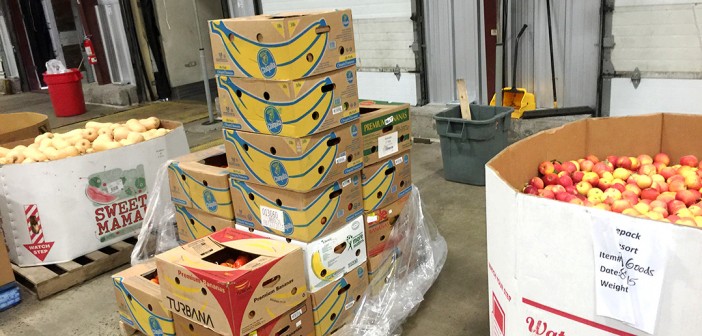Paul Lynch grew up poor.
His family of five lived in a crowded two-bedroom apartment in Whitehall – “beautiful Whitehall, the shopping mall of the world,” he called it. His mother, an immigrant from Scotland, earned just over $200 each week sewing the seams of men’s suits at a textile company. It was too little to live off of, Lynch said, and he and his brothers often didn’t have enough to eat.
To keep from going hungry, Lynch was fed sugar sandwiches – Wonder Bread, or the cheapest white bread they could find, with a little sprinkled granulated sugar over a margarine spread.
“This isn’t how anybody wants to live,” Lynch said.
Today, Lynch is the director of Second Harvest Food Bank of Lehigh Valley and Northeast Pennsylvania, the warehouse and food supplier for more than 200 non-profit organizations across Lehigh, Northampton, Carbon, Monroe, Pike and Wayne counties.
Last year, Second Harvest distributed 7.7 million pounds of food through its network of pantries, soup kitchens, homeless shelters, senior homes, childcare centers and rehabilitation facilities – feeding an estimated 69,000 people each month. All of the food dispensed by the food bank is free, underwritten by state and federal funding, as well as by donations from people in the community.
Second Harvest is based out of a monumental 65,000-square-foot warehouse off Route 512 and Silver Crest Road in East Allen Township. The towering metal structure juts off of the road, extending deep into an industrial lot where vendors unload food deliveries and agencies come to “shop” weekly.
Inside, the food bank houses offices for its 17 full time employees – as Lynch puts it, “We’re a pretty lean machine.” And around a sharp corner through a door in the back hall lies the center of the operation – a massive, fluorescently lit warehouse with sweeping rows of metal shelving units lined with cardboard boxes wrapped in plastic. Large clusters of bins filled with apples, squash and potatoes sit off to one side waiting to be picked up and carried across the concrete floor by one of the several forklifts.
“You can see the quality of the food,” Lynch said, pointing out some vegetables that had just come in. “It’s good quality food.”
Past the shelves extending into the far corner of the warehouse is an enormous metal container – its tall, reflective walls looming over the rest of the warehouse. Lynch explains that it is a massive refrigerator and freezer. He tugs on a rope hanging from the ceiling and the structure’s automatic sliding metal doors part. Plumes of cold air seep out through the opening revealing stacks of fresh produce, meats and dairy products.
Second Harvest relocated just last month, leaving behind its old home in Allentown that was just one-third the storage capacity of the new warehouse. Given the newly acquired additional space, Lynch anticipates that the food bank will distribute 9 million pounds of food this year – the equivalent of nearly 11 million meals, 2 million more than last year. And with the food bank’s continuing growth, and the growing need for hunger relief, he expects that the new warehouse will handle up to 34 million pounds of food annually.
Vickie Kahler, a retired teacher from Macungie, a town about 10 miles southwest of Allentown, has been volunteering at Second Harvest for four years. With more than 10 percent of Lehigh County families and one in five American children falling below the poverty line, Kahler says the scope of hunger today is shocking.
“What I’ve learned from doing this is how so many people still need to go to pantries and need food, even if they’re working – how what people are earning sometimes isn’t enough for a family,” Kahler said. “There’s so many people that need either help – clothing, food – or other resources to just survive daily life. People just don’t understand, I don’t think, how many people truly, truly need to be fed.”
The Hispanic Center Lehigh Valley is one of the 200 agencies that Second Harvest distributes to, feeding about 65 people each month. Bennie Khamneh, the center’s food pantry coordinator, said deliveries from the food bank are essential to stocking her pantry, which serves mostly retired seniors and low-income working families.
Khamneh said she loves taking advantage of Second Harvest’s “Free Fridays” – when pantries and soup kitchens can go to the warehouse and pick up goods that might go bad soon, adding extra food to her pantry to give to the hungry.
In addition to making food more accessible to thousands that need it, Second Harvest offers other accompanying resources to educate the community about making healthy eating choices.
They range from the Sunshine Boxes program geared towards senior citizens to the Backpack Buddies effort, which sends food for the weekend home with kids who get free lunch at school and might not eat again until Monday without it.
Cooking Matters is another program Second Harvest offers in which two nutrition educators on the food bank’s staff go out to pantries teaching low-budget families to add nutrition to their meals on a budget. The food bank also enlists the help of volunteer chefs and dietitians who develop recipes and educate pantries and other agencies how to use healthier ingredients.
“There’s a lot more emphasis on healthy food,” Lynch said. “Produce, chicken, milk – those kinds of products that people need as staples. … They may be poor, but they can eat better than they do.”
Given the breadth of Second Harvest’s reach, Kahler said they can always use extra help and that more people should give volunteering a try. She said helping out is every bit as productive as it is its own reward.
“Even if it’s an hour or two a week, I think everyone should do it,” she said. “It’s just so uplifting to know that I’ve worked hard and I did something that can help someone.”






Comment policy
Comments posted to The Brown and White website are reviewed by a moderator before being approved. Incendiary speech or harassing language, including comments targeted at individuals, may be deemed unacceptable and not published. Spam and other soliciting will also be declined.
The Brown and White also reserves the right to not publish entirely anonymous comments.